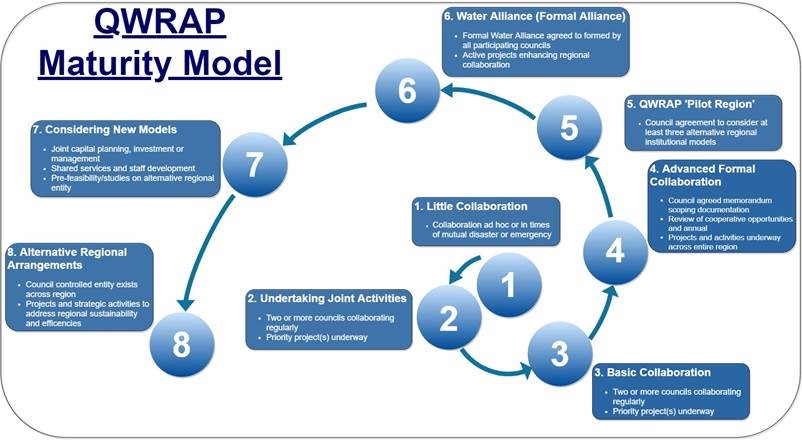
QWRAP has reached the end of another year with the Annual Report to be released shortly. The program is a collaboration among the LGAQ, qldwater, the Queensland Government (through the Department of Natural Resources, Mines and Energy) and over 30 participating councils. It has been funded by the Department since 2011 with significant leverage of cash and in-kind contributions from all other partners. The Program has evolved over time to include information sharing and joint projects among different regions.
QWRAP works to build regional collaboration for urban water and sewerage (W&S) services in Queensland because this approach has been proven repeatedly to be a sustainable way to support regional communities by addressing key service priorities and building workforce capability.
Multiple national reviews, most recently by the Productivity Commission, have urged regionalisation of Queensland utilities to strengthen economies of scale, improve strategic planning and investment and encourage competition by comparison. Acknowledging the necessity of a staged approach, the QWRAP ‘Maturity Model’ outlines typical steps in the development of regional models and directs funding to projects that demonstrate increasing maturity.
Five regions including over 200 communities are working through QWRAP on common projects and three have created formal Water Alliances. In 2020, the North Queensland ROC including Hinchinbrook, Charters Towers, Palm Island, Townsville and Burdekin were invited to form the sixth QWRAP region. The region’s technical group has been meeting for over two years to share information and resources with some bilateral projects undertaken already. Other Queensland regions have also commenced initial discussion about possible regional collaboration on W&S and are at various stages of developing joint projects.
Some of the projects finalised in the last year demonstrate how high-maturity collaboration can build sustainable services within and beyond a regional area. The first is a multi-region program developing skills for Water Industry Workers. This project has been successful in the past two years in building career paths for field and network staff responsible for maintaining levels of service for customers. The program provides a skilling platform that is important for attracting new staff and building essential skills in roles traditionally overlooked by many employers. The success of the program resulted in funding for an additional year and extending the work into another region to encompass ten coastal councils from Gympie to Cairns.
Another project has fostered cooperation on transitioning management of four sewage treatment plants from external contracts back to council management, thereby increasing employment in the participating councils and creating more sustainable management arrangements within the region. This high-value project was possible only through seed QWRAP funding which helped justify the collaboration and resulted in substantial savings for the councils involved. The high cost of the work combined with the projected ongoing savings and other community benefits make this a good example of the high collaboration maturity.
Another indicator of maturity is the willingness of the sector to engage in formal research and innovation and this interest has increased with the collaboration maturity of established regions. This year a new project was funded as a collaboration between regional councils and a local university to undertake a multi-year research project to assist in monitoring and managing levels of nutrients discharged to the Great Barrier Reef (GBR). Nitrogen has been identified by the Office of the GBR as the main water quality contaminant contributing to reef degradation and is also a key indicator of quality for sewage treatment. The research to develop ‘digital litmus paper’ for detecting nitrogen in GBR waters downstream of sewage treatment plants has the potential to deliver water quality improvements locally but also extending beyond the participating councils.
For more information please visit the recently update QWRAP website which includes Case Studies, Research Reports, Annual Updates and other documents describing how QWRAP is fostering regionalisation across the State.
QWRAP is funded until June 2022 by the Department of Natural Resources, Mines and Energy with contributions from LGAQ, qldwater and over 30 participating councils.